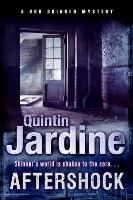|
The prolific
Quintin Jardine talks,
(eventually) about the creation of Aftershock,
the eighteenth book in his best selling DCC Skinner series.
It’s
almost twenty years since a journalist
turned spin doctor turned media relations consultant/guru sat down on
holiday
in Spain, and began, on an unfeasibly hot day, to write
his first novel. There
was nothing premeditated about it; I didn’t know I was going
to be a crime
writer, I didn’t know that on the first page I was going to
meet a character named
Bob Skinner, or that he was going to change my life, by giving me a
route out
of a career that I was enjoying less and less with each passing day,
for all
the modest trappings that it had brought me. I didn’t know at
all, but that’s
the way it was.
At that time, my
client list included the
Faculty of Advocates, (the Scottish bar) and Scotland’s
biggest firm of solicitors, so it was pretty much a given that the
first person
I killed was going to be a lawyer. (That’s not the dumbest
thing I’ve ever done;
it proved so popular with the reading audience that I’ve
bumped off a few more
since.) Big Bob’s birth wasn’t like that, though.
He appeared in my head, out
of nowhere, and jumped down on to the page.
Looking at him
there, in Edinburgh’s
rain-lashed old town, with my pal Tony’s steel-grey hair and
my black leather
overcoat, I made a strategic decision that I see in hindsight as hugely
important. Skinner wasn’t going to be one more mid-ranking
detective with a
100% clear-up rate and a career crippling personality problem . . .
I’m not
knocking that type of character, not at all; I didn’t want to
go there, that’s
all . . . he was going to be a high-flyer, who’d already
flown. That’s why the
man on my sweaty page one was a Detective Chief Superintendent, and
that’s why
he became an ACC half-way through the book.
I learned a lot
during the creation of the
work that became Skinner’s Rules,
eventually published by Headline in 1993, after a time-consuming
struggle to
find the right agent. I learned how to plot, I learned how to put on
the
clothes of different characters and think in different ways, I learned
how to
keep focussed on the action, and most important, I learned how to trust
my
instincts. That’s how I came to create a bloody,
quick-stepping story, a cityscape
full of crime scenes and body parts, leading to a confrontation in one
of the
city’s wealthier suburbs. And that’s how I came to
understand, without being
told, that it wasn’t finished. I was happy with it,
understand; the problem was,
I wasn’t happy enough. So I sat down again, looked at my
‘ending’, and asked
the most valuable question a crime writer can ever put to himself,
‘what if . .
.’ Sixty-five thousand words later, my original story had
been stood on its
head and finally, I was there. (There are people who will try to tell
you that
such moments are better than sex; they’re not, but
they’re pretty damn close.)
That’s why Skinner’s Rules
is the
only one of my works to be set in two parts, ‘Right and
righteous’ and ‘Adapt
and survive’ . . . two parts within a single book, that is.
As Samuel Goldwyn
probably didn’t say, we
have all passed a lot of water since then. Let’s wind on
seventeen years, and
I’m back in Spain, in somewhat larger premises, working on a
book known then only as
Skinner 17. Big Bob’s evolved, he’s now Deputy
Chief Constable, he’s gone into
and out of a marriage, he has a couple more kids, a new partner and
he’s
managed to age around six years. . . although his son is seven: work
that one
out. He’s on sabbatical; his troops are working on an odd
series of murders in
which the perp seems to have a down on young, female artists. To make
it even
odder, one of the bodies is found in his own home village. The story
evolves
and becomes a book called Death’s
Door,
published in July 2007, by Headline as always. The plot’s
tight, the killer
gets his, one of Edinburgh’s finest gets whacked in the
process . . . this is true;
on the very odd occasion where I’ve killed a good guy (good
gal once: I’m not
sexist) it’s never been pre-planned, always something
I’ve known instinctively
has to happen for the greater good . . . and in a final twist, Bob and
his
sidemen, Neil and Mario, are left frustrated by the disappearance of
the man
who made Maggie Rose a widow.
Except . . . about
half-way through the
book, I knew that wasn’t quite how it had happened. I had a
bigger story in my
head, one with plot, counter-plot, sub-plot, twist and finally an
enormous
rabbit being pulled out of a tiny hat. In other words, in a complete
reversal
of what had happened during the birth of Skinner’s
Rules and the birth of the series, I had far too much to fit
into a single
novel.
 That’s
how Aftershock, published on May
2008, the latest in a string of
Skinner No 1 best-sellers, came
to be .
. . not a fully formed plot at that time, but a clear road to follow .
. . and
I have to say that it was hell of a good feeling. The book begins with
DCC
Skinner and his team facing an awkward question; how come the young
female
artist who’s just been found dead in a wood was killed in
exactly the same way
as those bumped off by the guy who died in Death’s
Door? And another; how come the DCC has a picture painted by
each of the
dead women? Surely it couldn’t have been . . .
That’s
how Aftershock, published on May
2008, the latest in a string of
Skinner No 1 best-sellers, came
to be .
. . not a fully formed plot at that time, but a clear road to follow .
. . and
I have to say that it was hell of a good feeling. The book begins with
DCC
Skinner and his team facing an awkward question; how come the young
female
artist who’s just been found dead in a wood was killed in
exactly the same way
as those bumped off by the guy who died in Death’s
Door? And another; how come the DCC has a picture painted by
each of the
dead women? Surely it couldn’t have been . . .
More information :
http://www.quintinjardine.com
©
Portador 2008.

|


